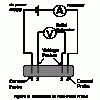I had no success the last few day to make a meaningful progress and am desperate for help!
What I want:
Measure copper foil resistance with the 4 probe methode, like here:

I put about 1A on the outer pins - and on the inner pins I measure 100-800µV (with a multimeter).
From here I like to feed that voltage to an instrument amplifier (I tried AD623 and INA126) - and I am stuck at that step.
Maybe InAmp is not the best way and there are better ways? I need an voltage that I can read with Arduino. How is not too important, hopefully not too expensive though.
What you suggest?
What I want:
Measure copper foil resistance with the 4 probe methode, like here:

I put about 1A on the outer pins - and on the inner pins I measure 100-800µV (with a multimeter).
From here I like to feed that voltage to an instrument amplifier (I tried AD623 and INA126) - and I am stuck at that step.
Maybe InAmp is not the best way and there are better ways? I need an voltage that I can read with Arduino. How is not too important, hopefully not too expensive though.
What you suggest?








